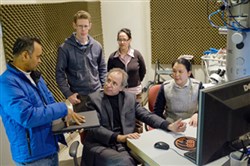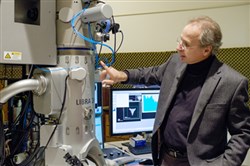VOL. 39 | NO. 9 | Friday, February 27, 2015
UT, Vanderbilt scientists are taking the science fiction out of invisibility
By Amanda B. Womac
Ferris Hall is an unassuming brick building on the edge of the University of Tennessee’s College of Engineering campus and home to the Department of Materials Science Engineering. There, Drs. Ramki Kalyanaraman and Gerd Duscher have opened the door to applying the magic of Hogwarts to military camouflage, cancer treatment or even Halloween costumes for a new generation.
It’s not a magic wand or a witch’s hat. It’s a cloak of invisibility.
And its discovery was an accident.
“Initially, we were exploring how to make new materials with better magnetic and optical properties so we could increase data storage,” says Kalyanaraman, associate professor of materials science at UT.
“We came up with ways to make new materials on a nanoscale and used an electronmicroscope to characterize the properties. That’s when the discovery happened.”
In the materials science world, silver is the best optical metal in existence. However, just like the silver in your grandmother’s china cabinet, it tarnishes and loses its optical luster.
Because of this, people tend to use gold as a metal for optical applications, which is much more expensive and not as good as silver in terms of its optical response.
“We were trying to figure out if there was any way to make silver last longer and not tarnish,” recalls Duscher, also associate professor of materials science at UT.
“Applying the principle of galvanic protection, we came up with another metal that had magnetic properties – cobalt.”
Think about a galvanized steel beam or a nail or sink cover. Galvanized steel does not tarnish because it is protected by an impervious barrier that does not allow moisture to come into contact with the steel. Without moisture, or the electrolyte, there is no corrosion.
Using silver as the stable compound, Kalyanaraman and Duscher chose cobalt to be the sacrificial element – the one that oxidizes away after applying heat.
According to the researchers, as a magnetic material, cobalt was supposed to be optically dead as a doornail, but when it made contact with silver, it suddenly showed an optical response.
“We were excited because in nature, there is no example of a magnetic material with a strong resonant optical response in the visible light range,” Kalyanaraman says.
Not a fluke
It was a complete surprise for both the researchers and their graduate students because no one could have predicted cobalt would react with silver in that way.

Ramki Kalyanaraman, left, talks with fellow UT researchers Gerd Duscher (seated beside grad student Jingxuan Gie). Undergraduate Connor Carr and grad student Annette E. Farah stand in back.
-- Chase Malone | The Ledger“We have stumbled upon a new metamaterial by accident, which is very exciting because how often does it happen that you find a new material,” Duscher exclaims.
After the researchers decided this optical behavior was not a fluke but a consistent property of cobalt, regardless of how they made it, they decided to experiment with changes in the intensity of heat applied, the shape and size of the cobalt and the distance between the silver and the cobalt.
“We want to understand where this optical effect comes from because the next interesting phase for us will be to see how we can actually couple magnetism and light,” Kalyanaraman explains.
“We want to discover if the magnetic component in cobalt could influence its optical behavior,” Kalyanaraman adds. If so, there is potential for invisibility and cloaking applications.
The process begins with a continuous film of silver and cobalt that resembles a slice of lasagna sitting on a plate.
Using a laser, the researchers heats the film, and the silver and cobalt layers turned into small drops similar to raindrops on a leaf after a storm.
Because the researchers specifically chose materials that do not mix, the end result was tiny balls of silver and cobalt with strong magnetic and optical interactions that show potential for applications in invisibility and cloaking.
Harry’s cloak?
So, does this make cloaking and true invisibility possible? Both researchers say it is theoretically possible, but more experimentation is needed to discover even better materials with stronger optical and magnetic properties.
“This is a fairly new field in terms of the experimental demonstration of invisibility,” Kalyanaraman adds. “Theoretically, it has been predicted from a mathematical foundation, but true invisibility has not yet been demonstrated.”
By definition, true invisibility occurs when no matter what side of an object you are on, you are able to see the other side clearly. However, most of the demonstrations of invisibility, including the silver and cobalt interaction, show the effect on one side of the object, but not the other.
Some element of cloaking exists because the light bends around the object from one side, but it is not the type of invisibility contained in Harry Potter’s fictional cloak.

Dr. Duscher at the electron microscope.
-- Chase Malone | The Ledger“We face a two-part problem,” Kalyanaraman explains. “The first part is what is the right material to make the cloak out of, and the second is how can we engineer the cloak to have all the materials arranged in a very specific fashion.”
Discovering the optical and magnetic interactions between silver and cobalt is a first step in the right direction. But another challenge before a cloak of invisibility can be made is the ability to replicate the interaction on a large scale.
In order to achieve invisibility, the magnetic and optical properties of the silver and cobalt need to be tightly controlled on an atomic scale. Also at this point in the discovery, invisibility occurs only in one direction.
“Having a large cloak like Harry Potter puts over himself will not likely happen anytime soon,” says Duscher. “But, we might be able to produce a throw cloth for your ugly wheelbarrow in the front yard!”
Both researchers, however, are hopeful and excited about the progress of their research thus far.
Military, medical interest
What began with a grant from the National Science Foundation to discover new metamaterials has blossomed into research funded by the Army to discover true invisibility.
“It’s clearly a military application,” Duscher notes. “If a vehicle cannot be seen, you will have a hard time shooting it.”
The medical world is probably the best example of where cloaking could be applied in the near future.
There are some computer chips in existence today that use light to communicate. If an invisibility cloak could be incorporated into the design, that light used to communicate could easily bend around the outer layer of the chip.
This could become a cheap communication device for someone with a robotic arm, for example.
“It’s very difficult to bend light, so if we can design structures in a way to where we don’t have to worry about obstacles in its path, you can use this invisibility to transfer information to the other side,” Kalyanaraman says.
This will most likely be the first realistic application, Duscher says, because there is no need for square yards of material, just the microstructure.
Another possibility for real-world applications of the strong optical and magnetic properties of silver and cobalt include medical tagging. Of course, this is nothing new in the world of nanoparticles.
For years, doctors have used nanoparticles to target specific areas of the body for cancer treatment and release a drug to kill the cancer cells.
A better understanding of the interactions and properties of silver and cobalt would give medical professionals another way to tag cancer growths.
“We know how to tweak the silver-cobalt system so that it’s responsive to infrared as well and not just invisibility,” Duscher explains.
With this understanding, doctors could use the system to make a patient’s body transparent and then direct the nanoparticles to a specific location to burn out the cancer cells.
For now, Kalyanaraman and Duscher are forging ahead with discovery and learning as much as they can about the silver-cobalt interaction in order to produce a better and more effective material.
The UT/ORNL Connection
Most of the work completed by Kalyanaraman and Duscher is done using resources available to them because of the relationship between the University of Tennessee and Oak Ridge National Laboratory (ORNL). In fact, they both came to UT because of this relationship.
“I could do materials science anywhere in the world, but I chose UT because of Oak Ridge,” Kalyanaraman explains. “We are fortunate to have the opportunity to collaborate with ORNL.”
“The lab has the best microscopes in the world,” adds Duscher, whose research focus is in electron microscopy, or studying what atoms do and what influences materials on an atomic scale.
He is also the scientific leader of the electron microscopy facility housed in the Joint Institute for Advanced Materials.
Established in 2005, the Joint Institute for Advanced Materials (JIAM) is a multidisciplinary team of scientists from the University of Tennessee and Oak Ridge National Lab. The Institute is one of five UT-ORNL joint institutes.
UT is also innovative and dynamic, especially in the College of Engineering, according to the researchers.
“UT is a great complement to ORNL because the lab is focused on producing results of cutting-edge research, but not training people in those techniques,” Kalyanaraman says. “We train graduate students who go to ORNL knowing how to conduct the research.”
“ORNL is very accommodating to graduate students,” Duscher adds. “They are handled as professionals. The concept of a ‘graduate student’ is not present at ORNL.
“Everyone is considered a post-doc or a researcher on the professional level and not as a student.”
Kalyanaraman and Duscher also receive support from UT’s Center for Materials Processing and the Center for Nanophase Materials Sciences at ORNL.
A Tennessee Center of Excellence, researchers with the Center for Materials Processing conduct research on the control of material properties through their composition and molecular structure.
At ORNL’s Center for Nanophase Materials Sciences, researchers use the facility to for the “synthesis, characterization, theory/modeling/simulation, and design of nanoscale materials … and to provide unique opportunities to understand nanoscale materials, assemblies, and phenomena through creation of a set of scientific synergies that will accelerate the process of discovery,” according to its website.
The partnership between UT and ORNL enhances research opportunities for not only graduate students, but for faculty as well. Several UT professors hold joint appointments with Oak Ridge National Lab, including Duscher.
Because of the UT-ORNL relationship, graduate students at the University of Tennessee have a great opportunity for research and obtaining their PhDs, which in turn improves the quality of graduate students working on their education in the College of Engineering.
Additionally, the relationship influences the hiring process, which in turn brings some of the world’s best and brightest researches to the East Tennessee community.
Kalyanaraman and Duscher will continue developing their research and with the help of graduate students and resources available through the joint centers of excellence, Harry Potter’s cloak of invisibility might one day, in the distant future, become a Halloween costume craze no one will see coming.